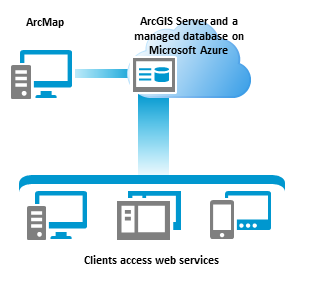ArcGIS Server en Microsoft Azure allows you to deploy a GIS Server or a full web GIS on Microsoft Azure virtual machines.
The advantages of deploying on Microsoft Azure include the following:
- You don't have to maintain hardware infrastructure.
- You can create or remove sites as demand requires.
Deploy ArcGIS Server en Microsoft Azure sites from images on Microsoft Azure Marketplace. From the images, use ArcGIS Server Cloud Builder para Microsoft Azure and your ArcGIS licenses to deploy the following:
- A GIS server: This includes an ArcGIS Server site and a managed database (enterprise geodatabase) in Microsoft Azure SQL Database or Microsoft SQL Server.
- Web GIS: This deploys the full ArcGIS for Server stack, which includes an ArcGIS Server site, Portal for ArcGIS, and ArcGIS Data Store.
You'll need a Microsoft Azure subscription to deploy these sites. When you deploy, you can choose different sizes for virtual machines and other components. You can use the Microsoft Azure pricing calculator to help determine costs of using various Azure components.
Deploy a GIS server
If you want to publish from local ArcMap clients to an ArcGIS Server site on Microsoft Azure, you can deploy a GIS server site. Web services you publish to ArcGIS Server on Azure can be consumed by ArcGIS and custom clients.
If you choose to, you can register an enterprise geodatabase in Azure SQL Database or SQL Server as ArcGIS Server's managed database. When your ArcGIS Server site has a managed database, feature service data is copied to the managed database when you publish. This allows ArcGIS and custom clients access to the feature service data outside your firewall.

See Deploy a GIS server on Microsoft Azure for instructions on setting up a GIS server.
ArcGIS Server Cloud Builder para Microsoft Azure allows you to set up multiple ArcGIS Server virtual machines and a shared location to store the GIS server's shared configuration store. Using multiple ArcGIS Server virtual machines allows you to distribute processing and connection loads.
Deploy web GIS
Web GIS allows you to share maps, applications, and files with other people in your organization through a website.
When you deploy web GIS, you set up a portal, a federated and hosting ArcGIS Server site, and ArcGIS Data Store to use with the hosting server. This allows members of the portal to do the following:
- Create and share maps containing data from the web, such as KML files, GPS exchange format files, or OGC Web Map Services.
- Create and share maps containing data from comma-separated values (CSV) files, text files, or shapefiles.
- Create applications from these maps and share them across your organization.
- Upload and share files, such as map templates, file geodatabases, locator packages, or PDFs.

See Deploy web GIS on Microsoft Azure for instructions on setting up web GIS.
You have the option to set up a web GIS that uses separate virtual machines for each component (ArcGIS Server, Portal for ArcGIS, and ArcGIS Data Store), thereby avoiding I/O and resource contention on any one machine.
Add a registered database
ArcGIS Server Cloud Builder para Microsoft Azure allows you to register an Azure SQL Database or SQL Server database with ArcGIS Server. Use this option if you want to place the source data for your web services in a database or geodatabase on Microsoft Azure.

See Register databases with ArcGIS Server on Microsoft Azure for information on using registered databases with a GIS server.